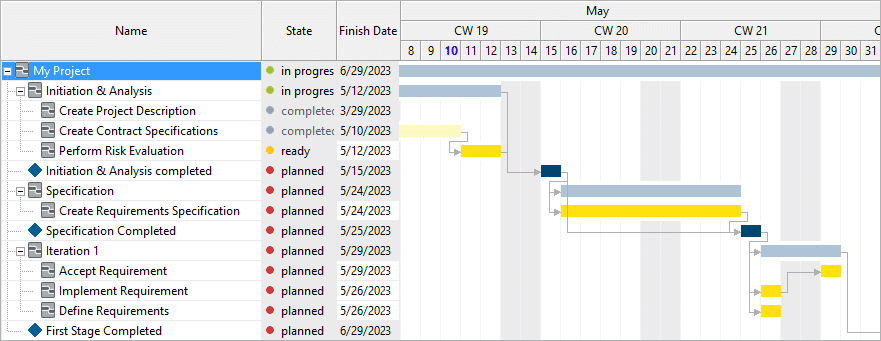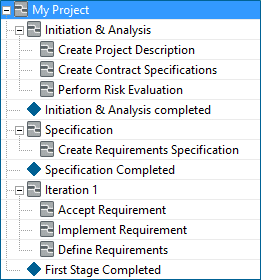Work Breakdown Structure. Hierarchically Order the Tasks of a Project.
Which advantages does a work breakdown structure offer and how do you create it?

The work breakdown structure (WBS) is a hierarchical structure of the project and creates a foundation for the planning of deadlines, procedures, resources and costs. In the text structure it is often presented in combination with a Gantt diagram.
What Is a Work Breakdown Structure?
With a work breakdown structure, the project can be ordered into tasks that have to be taken care of – so you structure the project. This structuring leads you until you can define detailed work packages to which you allocate editors and workloads. Through this the work breakdown structure can determine those responsible, the costs, deadlines and results for the tasks and you can create a foundation for the planning of your costs, deadlines, resources and processes. The plan also helps for your risk management, because you can recognize critical pathes with its creation. The work breakdown structure is also essential for the entire project planning. Based on the work breakdown structure, you can create Gantt charts.
The work breakdown structure is known from traditional project management, where you work according to the waterfall model. But even agile projects allow the implementation of the work breakdown structure, in that you dismantle the project, for example, into release and sprint activities. Often you can also find a hybrid work breakdown structure.
An Overview of the Advantages of the WBS
- Scope of performance of the project is completely displayed
- Project goal is defined
- Transparency is achieved for all project participants, for example, the stakeholders
- The foundation for further planning is mapped
- All tasks are determined with their benefactors
- A foundation is created by which to calculate the the resource implementation and the project costs
- Team work is easier because tasks can be precisely allocated and edited
- Risks can be identified (for example, if a project branch is not completely defined)
- Need for communication can be determined
Definition of the work breakdown structure from the Project Management Body of Knowledge (PMBOK):
A hierarchical decomposition of the total scope of work to be carried out by the project team to accomplish the project objectives and create the required deliverables.
Presentation of the Work Breakdown Structure
Work breakdown structures have to be clear. That is why two presentation forms have developed from them: tree structure and text structure. Sometimes a mind map is also used for presentation.
The tree structure is a strong visual means: it begins with the project activity and outsources the tasks to the next levels so that twigs emerge. The tree structure of the project plan can go from the top to the bottom or from the right to the left.
The presentation of the text structure orders the tasks as a list in which the entries are inserted according to their breakdown level. If the project has a large number of tasks, you would like to enter further information like beginnings and ends for the tasks or adapt everything to fit on one page, then this presentation is recommended.
If you select the text structure, you can also display a Gantt chart of your project alongside it – that way you can visualize the chronological order of your tasks.

Example of a WBS text-structured
Structuring the Work Breakdown Structure
The work breakdown structure creates a hierarchy of tasks. According to the complexity, you can create multiple levels in a WBS.
The first level of the work breakdown structure is always the project itself. That is followed by partial projects, for example, which are structured into work packages. You can also insert another level for partial tasks that follow after the partial projects and gather the work packages. You have to decide how detailed you want to be for each project. There are four approaches for structuring projects:
Function-Orientated Structuring
These forms of structuring the work breakdown structure handle all tasks or levels as activities. That is why partial projects, tasks and work packages are described with a verb, like Create specifications or Execute target group analysis. This structure can also be orientated toward business features like Sales and Distribution.
Object-Orientated Structure
The object-orientated structure is recommended when the product – so the result of the project – should be the focus. Through this, a structuring according to components, building groups and individual pieces arises. In this structuring form, tasks are then read as, for example, specifications or target group analyses.
Phase-Orientated Structuring
In the phase-orientated structuring, the project is divided into work levels. For example, in a classical work breakdown structure, the phases preparation, planning and implementation are found.
Mixed Forms
It is also possible to mix the structuring forms. This is indispensable in many projects and even necessary. However, the following rules apply: you have to select the same structuring for for your partial projects, partial tasks and work packages. What does this mean? You can’t plan one partial project, one twig of the work breakdown structure object-orientated and another function-orientated. Instead, consider the entire project and plan, for example, all tasks object-orientated and all work packages function-orientated.
Project Management in Practice
Creating the Work Breakdown Structure
To determine the tasks of your project, you can get from the general tasks to the detailed work packages or vice versa: first define the work packages and then bundle them with tasks and projects. These procedures are called top-down and bottom-up:
Top-down:
Dismantle the project from the top to the bottom to get to tasks and then to work packages. This method is recommended if you know the projects as far as possible because you have already planned similar projects, for example.
Bottom-up:
Plan from the bottom to the top to get to tasks from your work packages. If you approach a project whose entire contents are not yet determined, then this procedure is recommended. You can also let project workers determine and plan the necessary work packages in each field themselves.
In practice, a combination of both methods is reliable, because then all project tasks can be found more easily.
Create a basis with the work breakdown structure
With the work breakdown structure you can create a hierarchical structure of your tasks in projects and so prepare the planning of your appointments, procedures, resources and costs. That is why the WBS is an ideal tool to plan and control your projects. Support yourself and your team with a tool you can use to simply create projects, tasks and work packages, and simply allocate deadlines, resources and workloads. Even changes to the plan can be easily updated. And if you would like to display Gantt charts, the software can do it for you with a few clicks.
